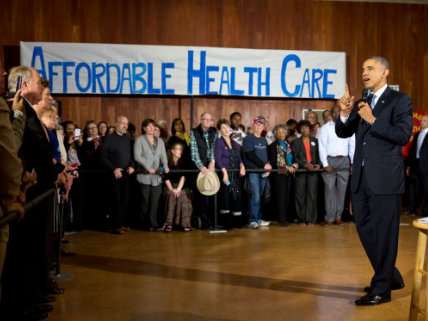Obamacare Sees Last Minute Sign-Up Surge, But How Many Enrollees Were Previously Uninsured?

It's the final day for Obamacare's official open enrollment period. (The special open enrollment period for folks who miss out the first time around starts tomorrow.) The day started with a website outage. Between 3 a.m. and 9 a.m. the federal health insurance exchange at the heart of the law was down, and unable to process new applications.
Obama administration officials say it was a software bug that popped up during scheduled maintenance. It probably didn't have anything to do with the crushing traffic load that was reported over the weekend. Via The Wall Street Journal, enrollment points online and off were slammed over the last few days:
Federal officials said HealthCare.gov had two million visitors over the weekend. On Friday, the site had blocked people trying to log in for about two hours starting at 4 p.m. Eastern, and they were told to wait until the site had fewer users, said a person familiar with the site's operations. On Sunday, the site was holding up well, the person said, handling some 50,000 simultaneous users, up from a previous peak of 40,000.
Long waits to reach a federal call center for help also frustrated some applicants. Federal officials said the center received about 270,000 calls Saturday from people trying to apply by phone or resolve problems with their online application.
The Journal, along with other news outlets, reports that enrollment centers faced long lines over the weekend. Combined with last week's announcement of 6 million sign-ups, it looks like this year's open enrollment period will finish with a last minute surge. At this point, I expect we'll see at least 6.5 million sign-ups by the end of today. It could easily be 6.7 million.
But as insurance industry consultant Bob Laszewski argues, this isn't the number we really want to know.
Of course, the more than 6 million enrollment the administration recently announced overstates Obamacare's success because this includes enrollments that were never completed since the person never paid the premium. There are lots of reasons why a consumer might not complete the enrollment. The person may have hit the enroll button a number of times and ended up paying only once. It may have been one of the infamous "834" transactions that never made sense and the consumer ended up having to enroll again later. Or, the person might have had second thoughts about the cost/benefit of Obamacare and decided not to move forward.
Then there were a measurable number of people who paid their first month's premium but never paid the second month's premium. I am told that 2% to 5% of January's enrollments never paid in February, for example.
Whatever the reason, the real enrollment number will likely be about 20% lower than what the administration finally reports.
It's not just that the sign-ups figure provided by the administration don't reflect real enrollments. It's that they don't tell us about the net gain in the number of uninsured.
There are two important pieces of information we need to have before the country can really answer this fundamental question about the way Obamacare accomplished health insurance reform:
- How many people have actually paid and completed their enrollment?
- To what extent have we reduced the ranks of the uninsured—how many of these people who enrolled were previously insured and how many of them were previously uninsured?
Reporters often ask these questions and the Obama administration says they don't know. And, that's the end of it.
But these questions are easily answered.
Every insurance company knows exactly how many people it has enrolled and who paid their premium at the end of every billing period. How else would they be able to process the claims for these people?
We'll probably get this information eventually. And we'll certainly get surveys and other attempts to quantify the changes in the meantime. But I think it's going to be a while before we have a reliable count of how many have enrolled, and how many are newly insured.


Show Comments (82)